How curious are you as a horse owner? Do you want to know how things work, what they look on the inside, and if they’re as good as the makers say – right the way through?
The guts of any piece of equipment are usually less pretty than the exterior, but nevertheless, we’re often happy to take the manufacturer’s word on trust.
Yet when the marketing message is that a particular brand is actually healthier for the horse’s back on account of its inbuilt ‘systems’, it’s definitely time to take a closer look. Consider a message such as this:
“Naturally, horses will demonstrate a marked improvement in performance when changed to a saddle featuring CAIR®.”
http://www.easychangefitsolution.com/saddle_brands/wintec-saddles.html (13/3/2017)
That’s pretty grand, isn’t it? How wonderful if it were only true. But working in Australia, birthplace of Weatherbeeta, Bates and Wintec, and a chain of saddlery stores that sells and fits these saddles, which is owned by that same company, I do find much evidence that persuades me otherwise.
At this point, I must make my usual disclaimer: I have no problem with any saddle that genuinely fits the horse. I do have a problem with misleading claims, intentional or otherwise, as expressed in my earlier article, Debunked: The Lie That’s Told About Adjustable Saddles.
© All text copyright of the author, Jane Clothier, https://thehorsesback.com.
CAIR for the horse – or EASY-Marketing?
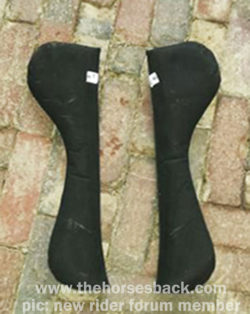
Google CAIR and you’ll find it described as the “revolutionary CAIR® Cushion System for the ultimate performance panel”.
Navigating a range of websites, you might also discover that it is accompanied in saddles by the EASY-CHANGE® Gullet System and the EASY-CHANGE® Riser system.
Together, these three comprise the EASY-CHANGE® Fit Solution.
Confused yet? No matter, as you can read all about it on the EASY-CHANGE® website…
Crazy as I find the labelling, and let’s be honest, the brand marketing department has gone a bit nuts, what really bothers me is that these much vaunted systems are not doing what it says on the packet. Nowhere near.
The problem with systems…
In my view, systems often evolve to the benefit of the people who operate them. That is fine: they make problems easier to understand and easier to navigate – and saddle fitting is certainly a problem when you can’t find the right fit for your horse.
So if a system results in a better saddle fit and, as the website suggests “your horse’s absolute comfort and your peace of mind”, all well and good.
But where systems go wrong is when the function of making life easier for people is given more importance than the problem they were originally intended to resolve.
Or, indeed, when they become an effective way of achieving increased sales through the handy marketing push they make possible.
And this bugs me because the horse’s much vaunted comfort is usually by this stage sliding further and further down the importance pile. Like a growing number of equine professionals, I’ve taken a look inside these saddles, and something simply isn’t adding up between the message and the reality.
At this point, I will say no more, but instead present some of the website content I’ve been reading this month. Alongside it, you’ll find some photos that I and others have taken.
Beyond the photo captions, I’ve made no comment until the last section on flocking. I found that had no choice, because the ‘secret flock sock’ is so secret, I can find no website content about it… Let’s just say that seems a little unusual.
“The CAIR® Cushion System”
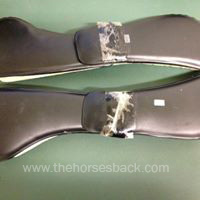
“Fluidly working with your horse’s muscles, the revolutionary CAIR® Cushion System replaces traditional fillings in your saddle with air. The cushioning nature of air encourages your horse to soften, relax and engage. Seated closer to your horse, you become simply an extension of one another. Transcend into a new world of opportunities through the power of true connection. Empower your horse with the ultimate in comfort, and explore your true potential together with the CAIR® Cushion System. ”
http://caircushionsystem.com/noflash.htm (13/3/2017)
“CAIR: The Power of True Connection”
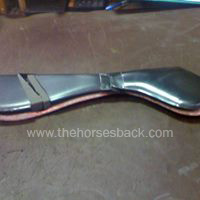
“Finally a panel system that understands the mechanics of the equine back and the impact saddles have on horse and rider performance. The revolutionary CAIR® Cushion System replaces the traditional fillings in your saddle panel with air. There are two independently sealed Air Cushions within each Saddle Panel. The concept of air, as the ultimate in cushioning for the horse is simple.”
http://caircushionsystem.com/whatIsCAIR/index.htm (13/3/2017)
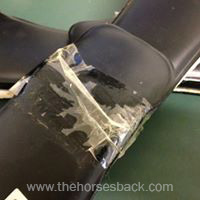
“Air being a fluid medium will constantly adapt to the horse’s working muscles. This means that your weight will be distributed evenly across the entire length of the cushion, virtually eliminating pressure points. This extraordinary comfort results in freer movement, better carriage and a happier horse. For such a simple concept the dramatic difference the CAIR® Cushion System makes to a horse’s comfort and performance is profound.”
http://caircushionsystem.com/whatIsCAIR/index.htm (13/3/2017)
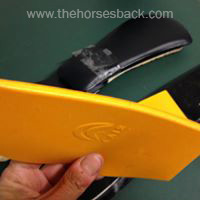
“The award winning CAIR® Panel Insert System was launched to retailers and saddle fitters around the world. Together with the tree adjustability of the EASY-CHANGE® Gullet System, this delivered a whole new level of adjustability in saddles. The insert system enabled retailers and saddle fitters to make adjustments within the panel effectively, efficiently and to the highest professional standards.”
http://www.easychangefitsolution.com/easy-change-story.html (13/3/2017)
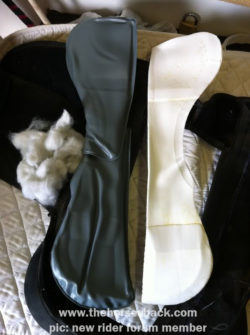
“The challenge lies in developing an air system that limits any opportunity for human interference on the performance of the panels.
“The cutting edge Research and Development Team at Bates Australia have spent many years refining and perfecting techniques for incorporating an air cushion into a saddle panel, before reaching a breakthrough in manufacturing method.
The CAIR® Air Cushions are shaped and refined at the point of manufacture to provide an even thickness throughout the panel….”
http://caircushionsystem.com/
whatIsCAIR/evolution.htm (13/3/2017)
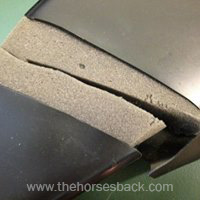
“What is Inside an Air Panel?”
“Air is captured at atmospheric pressure in an open-celled foam and sealed in the Air Panel. Once the air panel is welded the open-celled foam becomes irrelevant, as it is the air trapped in the panel, which is doing the work.
Furthermore, the balance of saddles with the CAIR® Cushion System is easily altered without compromise to the performance of the air panels.”
http://www.caircushionsystem.com/faqs/index.htm (13/3/2017)
** Questions, thoughts or comments?
Join us at The Horse’s Back Facebook Group.
“How adaptable are the saddles for achieving an optimal fit?”
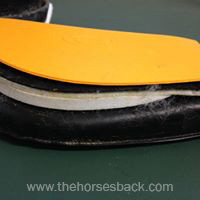
“Extremely, Saddles that feature both the CAIR® Cushion System and EASY-CHANGE Gullet System are unsurpassed in the flexibility they offer for achieving an optimal fit.
Once you have selected the correct gullet size for your horse, the CAIR® Panel Insert System enables you to alter the balance of your saddle without compromising the performance of the Air Panels.”
“Official Fit Disclaimer”
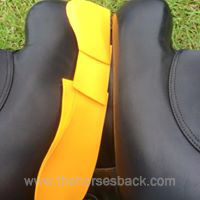
N.B whilst the innovative EASY-CHANGE® Fit Solution offers unsurpassed flexibility in achieving an optimal fit, no one saddle can claim to fit every horse. It is always recommended ongoing professional advice is sought on the fit and in meeting the unique needs of each horse/rider combination. Global patents and design registrations apply.
http://www.easychangefitsolution.com/easy-change_fit_solution/index.html (20 Sept 2015)
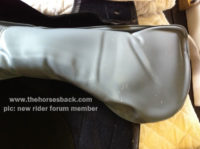
“The Current Day…”
“Bates Australia has now developed a means of offering these saddle fitting systems in both saddles featuring high performance CAIR® panels, as well as traditional flocked panels.”
http://www.easychangefitsolution.com/easy-change-story.html (13/3/2017)
But Hang On… “Traditional flocked panels”… What are they talking about?
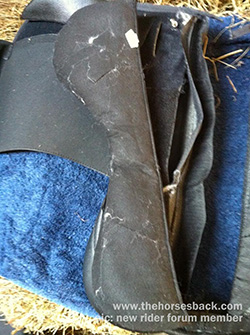
OK, this is where I break my silence. This is where I introduce the flock panel insert.
The thing is that for the past 2-3 years, other company saddlers have been finding these rather strange, stuffed fabric panels inside Wintec and Bates saddles brought in by customers requesting reflocking.
These fabric sleeves, which are the same shape as the vinyl CAIR sleeve, are packed hard and tight, meaning that the usual benefit offered by flocking – ie, ability to mould to the horse’s shape – is lost altogether. You won’t hear about that though, because this is a manufacturer’s secret (shhhh).
Where Can We Find the Flocking Info?
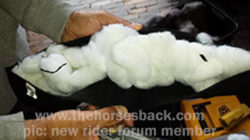
Oddly, and strangely given all the Easy web pages, this ‘flock sock’ doesn’t have its own page and isn’t photographed on any of the Wintec, Bates and EASY-whatever websites.
Why? I’d speculate that the sock removes considerable time and dollars off the manufacturing cost of flocked saddles, without adding much that’s positive at the horse end of the equation.
[ed note. I’ve removed the detail about pricing here, because I made a mistake with it. That obviously isn’t good enough. I’m sorry about that.]
So, why is nobody hearing about this little innovation? The company don’t want to add flocking to saddles as it’s less profitable, but is offering ‘flocking’ (or their own version of it) simply to satisfy customer demand. Unfortunately, with this inner working of the saddles kept out of sight, the customer simply doesn’t know what they’re paying for.
And how good is that for the horse’s interests, we must ask?
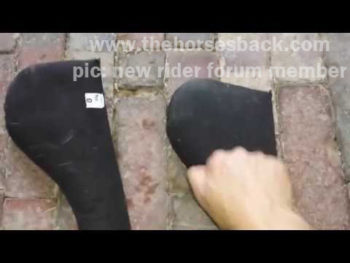
** Questions, thoughts or comments? Join us at The Horse’s Back Facebook Group.
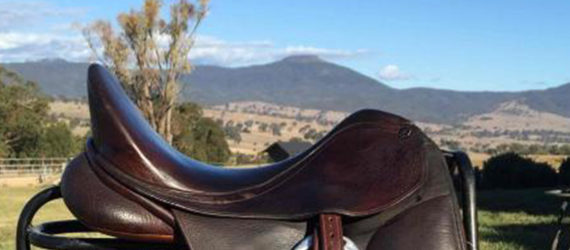
In thinking about the various air flocking systems, ambient air pressure drops around 1/2 PSI for every 1,000 foot gain in elevation which could, or so it seems, result in the air bags becoming over filled and bouncy similar to what a potato chip bag will sometimes do in the mountains.
Well said Jane!!
omg and I was
just about to order one of
these Wintecs with the easy gullet etc for my TB
thanks
Finding the right saddle is a nightmare. So many factors are involved and knowing who to trust when it comes to reflocking or adjusting is not easy either. Manufacturers are indeed fixated on ‘Introducing The Latest System’. Sometimes I wish I could use the ‘Totally Invisible System’, but sadly I’m a bit too old to try it seriously.
Fi Myles
The ‘flock socks’ I’ve come across in UK saddles have been leather rather than fabric bags and flocked softly. Problem is that you can’t actually adjust them in situ because their slots never line up with those in the external panel.
Of course you’re right – use of Cair and flock bags both cheapens and speeds up saddle production while making them more difficult to fit in the conventional sense.
Thank you for this insight. I have only had one saddle ( a second hand one ) and it was awful. The saddle was unbalanced, rolled like a wet sponge and despite numerous visits from a fitter, it constantly slipped.
I also hate changeable gullet systems on fully developed, mature horses. They have a place in the market when young horses change and grow but too many people with very little knowledge of saddle fitting, rely on them all the time in order to avoid the cost of a proper saddle check on a regular basis.
Conversely, it has to be said that I think saddle fitters need a bit of a shake up about their charges and the advice they give. Why can’t there be a proper examination/regulatory body for this profession? The fit is as important as the making of saddles and just as likely to cripple as bad shoeing or not having teeth checked!
Edited to add: the awful saddle was one with the Cair system. I have owned many excellent wool flocked ones.
WOW! What an eye opener!
We had a 2004 Bates Caprilli, left front air panel deflated. I had no idea the then 9 year old saddle even had air bags. The saddle was lightly used. I kept after my daughter about being one-sided and dropping a hip and shifting the saddle. Chiropractor for her – all fine. Horse’s stride short on the left side. After the vet and chiropractor, I called a saddle fitter. Saddle fitter opened up saddle and showed me the air panel. Reminded me of a Ziploc bag that’s been heat sealed and the seal failed.
I was told that I either had to send the saddle back to Bates in Australia to have the bag replaced or to a saddle fitter to change it over to flocking. I was told the air bags generally last 2 years if you ride often, and that I should have all of the panels replaced if I went through the trouble of sending to Bates. The other option meant finding a saddle fitter or maker capable of rebuilding for flocking and that very few would be willing to gut the saddle to rebuild for proper flocking, complete with ports. Either way, it was expensive. Plastic, tape, staples and baggies just don’t sit well with my old school concept of a saddle tree and padding.
The horse had muscle injury to the shoulder from the blown bag which has taken quite a long time to rehab and numerous bills.
Conclusion: I am NOT impressed with CAIR and ABSOLUTELY WILL NOT BUY another saddle with air bags.
Hi,
Do you know if you can remove the panels and then open them up? Could the panels themselves be reflocked with wool and then reinserted? Thank you for all the great info.
Michele
If you replaced the internal foam with flock in the panel itself, you’d have the same outcome. A good saddler can remove the insert altogether and refill the panel – ie the leather or synthetic material panel that sits against the horse – with wool flock. You’re then basically back to the traditional form of saddle.
Thank you for the info. I’ll take it to a saddle fitter. Michele
Hi, can flocking be done with HART? Horse and rider technology as I have an arena saddle.
penni
Hi Penni, this is a rebranding of the CAIR system. I’d recommend first talking to the store that sold you the saddle.
Hi,
I would just like to add, if you buy a Cair branded saddle that claims to now be flocked do please check inside it.
I have just trialled one and upon inspection the air bags had been lightly filled with flock, thus just a thin foam pad (2mm) and an ex air pad (4 quarter pads, the older style I believe as now they are in twos), was all that would be supporting my weight on the saddle tree on my horses back. Oddly a little flocking was visible externally which leads me to believe who ever did this ‘conversion’ was attempting to convince a would be purchaser that it was flocked correctly. It would have caused awful damage if it had been used, so please do check the contents of that converted saddle before strapping it to your horses back.
Hi I also had a Bates Cair Saddle and did not realise the bags could burst . Unusually for my horse he bucked and bucked until I fell off . Broken pelvis, ribs and foot . They should put a warning on the saddle
I’m not clear on the message. Is the CAIR system bad?